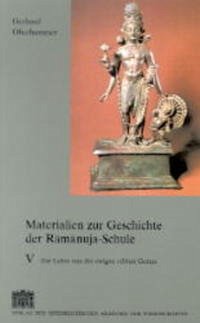In diesem fünften Band der „Materialien zur Geschichte der Ramanuja-Schule” wird die für die Ramanuja-Schule charakteristische Lehre von der ewigen vibhuti Gottes in ihrem Werden von den Anfängen bis hin zu ihrer klassi- schen Form (Ven . kat .an a tha, ca. 14.Jh.n.Chr.)und ihrem Fortwirken bei Œ r i niv a s a c a rya und N a r a ya n .amuni (ca.16.Jh.n.Chr.)an Hand der wenigen erhaltenen Sanskrittexte dargestellt:von den Anfängen dieser Lehre in der Bhagavadgita, in der der Begriff der vibhuti die wirkende Gegenwart Gottes in der Schöpfung bzw. das besondere Seiende in der Welt, in denen diese wirkende Gegenwart zur Erscheinung kommt, bezeichnet, über die Deutung des Begriffes bei Œ an . kara bis Ramanuja, der den Begriff der vibhuti als „Lenken” (niyamana) der Schöpfung bzw. als das Zur-Erscheinung-Kommen dieses Lenkens im gesamten Seienden der Welt als „zu Lenkendes” (niy a mya) bestimmt und damit den entscheidenden Anstoß zur Entwicklung der Lehre von der nach ihm als „Substanz” verstandenen, ewigen vibhuti gibt. In einem abschließenden Abschnitt wird versucht, die Entwicklung dieser Lehre zusammenzufassen und religi- onshermeneutisch zu deuten. … In this fifth volume of the ”Materialien zur Geschichte der Ramanuja-Schule“ the growth of the Ramanuja school’s characteristic teachings of the eternal vibhuti of God is described, from the rudiments to their classical form (Ven . kat .an a tha, ca.14th century A.D.) and their continuing effect on Œ r i niv a s a c a rya and N a r a ya n .amuni (ca.16th century A.D.), using the few Sanskrit texts still preserved: From a description of the beginnings of these teachings in the Bhagavadgita, in which the concept of the vibh u ti describes the acting presence of God in the creation, or the special Being in the world in which the acting presence is manifested, continuing to the interpretation of the concept by Œ an . kara, and to Ramanuja, who defines the term vibhuti as thecreation’s ”control“ (niyamana) or the manifestation of this control in all beings of the world as ”to be controlled“ (niy a mya ), and so gives the decisive impulse for the development of the teachings which, following Ramanuja, understand the eternal vibhuti as ”substance“. The closing section is an attempt to summarize the development of these teachings and to interpret them through hermeneutics of religion.
